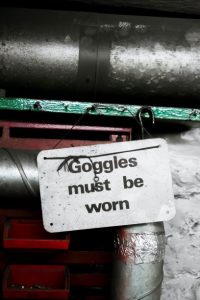Know the hazards, use protective eyewear, and get regular exams
Posted August 7, 2020
 August is Eye Health and Protection Month, and SynTerra is doing its part by raising awareness about the use of protective eyewear in the workplace and at home, the different types of hazards to the eyes, and the importance of regular eye exams. Between 2011 and 2018, there were on average 230,000 contact-related work injuries per year. Fourteen thousand injuries were to the eye. (NSC.org)
August is Eye Health and Protection Month, and SynTerra is doing its part by raising awareness about the use of protective eyewear in the workplace and at home, the different types of hazards to the eyes, and the importance of regular eye exams. Between 2011 and 2018, there were on average 230,000 contact-related work injuries per year. Fourteen thousand injuries were to the eye. (NSC.org)
In 2018, exposure to harmful substances or environments resulted in over 40,000 nonfatal injuries and 621 fatalities. Eighteen percent of those injuries were on the head, with the eyes being the primary area affected.
Eye injuries can be caused by impact, heat, chemicals, dust, glare, and optical radiation. The Bureau of Labor Statistics (BLS) has found that almost 70 percent of eye injuries were caused by flying or falling objects or sparks striking the eye.
While eye hazards are found in every industry, BLS reported more than 40 percent of injuries studied occurred among craft workers, such as mechanics, repairers, carpenters, and plumbers. Over one-third of the injured workers were operators of equipment such as sanders, grinders, and assembly machines.
For employers, hazard assessments are essential for identifying engineering controls and administrative controls to reduce eye injuries. When these controls are insufficient or in cases where it is mandatory, the correct protective eyewear must be selected and used. It is estimated that 90 percent of eye injuries can be prevented through the use of proper protective eyewear.
BLS has also reported that an effective safety program that includes proper training on the use and limitations of protective eyewear and other personal protective equipment (PPE) can also help reduce the frequency of eye injuries.
Proper eye protection:
 To protect eyes, it is important to wear the correct PPE, such as goggles, face shields, safety glasses, or full-face respirators, depending on the hazards of the work being performed. Personal vision needs are an important factor when choosing the right protective equipment.
To protect eyes, it is important to wear the correct PPE, such as goggles, face shields, safety glasses, or full-face respirators, depending on the hazards of the work being performed. Personal vision needs are an important factor when choosing the right protective equipment.
The primary requirements set forth by the Occupational Safety and Health Administration (OSHA) for eyewear include the following:
- Employees must use appropriate eye or face protection when exposed to eye or face hazards from flying particles, molten metal, liquid chemicals, acids or caustic liquids, chemical gases or vapors, or potentially injurious light radiation
- Eye protection must provide side protection when there is a hazard from flying objects
- Each affected employee who wears prescription lenses while engaged in operations that involve eye hazards must wear eye protection that incorporates the prescription in its design
- Protective eyewear must meet ANSI Z87.1 standards
- Each affected employee who wears prescription lenses while engaged in operations that involve eye hazards wears eye protection that incorporates the prescription in its design
- Each affected employee must use equipment with filter lenses that have a shade number appropriate for the work being performed for protection from injurious light radiation
In addition, wearing proper eye protection when performing tasks like cleaning, or maintenance around the home is just as important as wearing protection in the workplace.
SynTerra works to ensure our team is equipped with proper eye safety protection and knowledge. If your company needs assistance with the various components of a safe workplace (safety programs, hazard assessments, PPE selection, or training), contact Paul Tarquinio to see how SynTerra can help.





 August is Eye Health and Protection Month, and SynTerra is doing its part by raising awareness about the use of protective eyewear in the workplace and at home, the different types of hazards to the eyes, and the importance of regular eye exams. Between 2011 and 2018, there were on average 230,000 contact-related work injuries per year. Fourteen thousand injuries were to the eye. (
August is Eye Health and Protection Month, and SynTerra is doing its part by raising awareness about the use of protective eyewear in the workplace and at home, the different types of hazards to the eyes, and the importance of regular eye exams. Between 2011 and 2018, there were on average 230,000 contact-related work injuries per year. Fourteen thousand injuries were to the eye. ( To protect eyes, it is important to wear the correct PPE, such as goggles, face shields, safety glasses, or full-face respirators, depending on the hazards of the work being performed. Personal vision needs are an important factor when choosing the right protective equipment.
To protect eyes, it is important to wear the correct PPE, such as goggles, face shields, safety glasses, or full-face respirators, depending on the hazards of the work being performed. Personal vision needs are an important factor when choosing the right protective equipment.